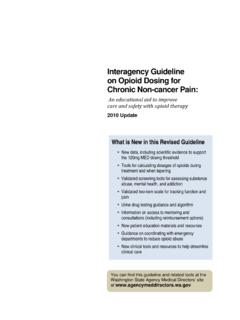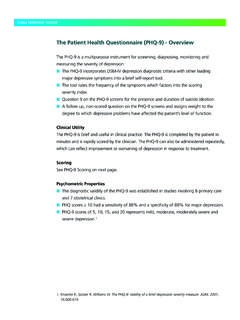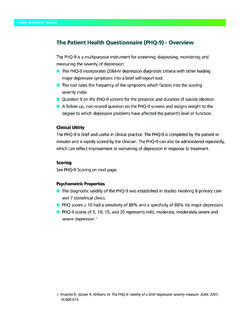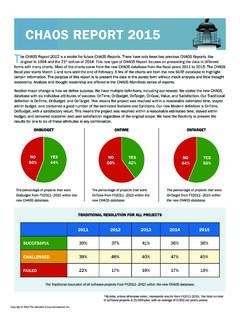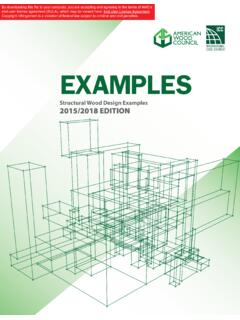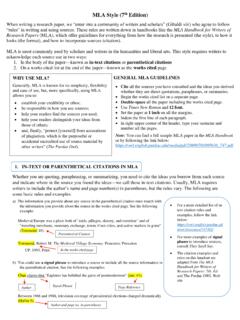Transcription of Interagency Guideline on Prescribing Opioids for Pain
1 Interagency Guideline on Prescribing Opioids for Pain Developed by the Washington State Agency Medical Directors Group (AMDG) in collaboration with an Expert Advisory Panel, Actively Practicing Providers, Public Stakeholders, and Senior State Officials. Written for Clinicians who Care for People with Pain 3rd Edition, June 2015 Interagency Guideline on Prescribing Opioids for Pain [06- 2015 ] 2 Table of Contents A MESSAGE FROM WASHINGTON S SECRETARY OF HEALTH .. 4 COMPARISON OF 2010- 2015 guidelines .. 5 INTRODUCTION .. 6 Correct Diagnosis and Realistic Expectations .. 6 Uncertain Long-term Efficacy, Clear Evidence of Harm.. 7 Opioids and Chronic Disability .. 8 PART I. RECOMMENDATIONS FOR ALL PAIN PHASES .. 9 Clinically Meaningful Improvement in Function (CMIF) .. 9 Dosing Threshold .. 11 Non- opioid Options for Pain Management .. 14 PART II. Prescribing Opioids IN THE ACUTE AND SUBACUTE PHASE.
2 22 Opioids in the Acute Phase .. 22 Opioids in the Subacute Phase .. 23 PART III. Opioids FOR PERIOPERATIVE PAIN .. 26 Preoperative Period .. 26 Intraoperative Period .. 27 Immediate Postoperative Period .. 27 At Time of Hospital Discharge .. 29 PART IV. Prescribing Opioids FOR CHRONIC NON-CANCER PAIN .. 32 Opioids in the Chronic Phase .. 32 PART V. REDUCING OR DISCONTINUING CHRONIC opioid ANALGESIC THERAPY (COAT) .. 36 Reasons to Discontinue COAT and Considerations Prior to Taper .. 36 How to Discontinue Opioids .. 37 PART VI. RECOGNITION AND TREATMENT OF opioid USE DISORDER .. 40 PART VII. CHRONIC PAIN MANAGEMENT IN SPECIAL POPULATIONS .. 42 Managing Chronic Pain during Pregnancy; and Neonatal Abstinence Syndrome .. 42 Managing Chronic Non-cancer Pain in Children and Adolescents .. 45 Managing Chronic Pain in Older Adults .. 47 Managing Chronic Pain in Cancer Survivors.
3 49 PART VIII. APPENDICES .. 54 Appendix A: opioid Dose Calculations .. 55 Appendix B: Validated Tools for Screening and Assessment .. 59 Appendix C: How to use the Prescription Monitoring Program .. 60 Appendix D: Urine Drug Testing for Monitoring opioid Therapy .. 62 Appendix E: Chronic Pain Syndromes in Cancer Survivors .. 72 Appendix F: Diagnosis-based Pharmacotherapy for Pain and Associated Conditions .. 74 Appendix G: Patient Education Resources .. 76 Appendix H: Clinical Tools and Resources .. 78 Appendix I: Guideline Development and AGREE II Criteria .. 81 ACKNOWLEDGEMENTS .. 87 REFERENCES .. 89 Interagency Guideline on Prescribing Opioids for Pain [06- 2015 ] 3 Table of Figures and Tables Figure A. Three Item PEG Assessment Scale .. 10 Figure B. Two Item Graded Chronic Pain Scale .. 10 Figure C. Risk of Overdose Events in Four Different Populations.
4 12 Figure D. Infant Hospitalizations for Neonatal Abstinence Syndrome in WA State 1990-2013 .. 44 Figure E: UDT Algorithm for Monitoring COAT for 67 Table 1. Cognitive Behavioral and Non-pharmacological Therapies for Chronic Pain .. 14 Table 2. "Red Flags" Indicating Need for Further Patient Evaluation .. 15 Table 3. Recommended Sleep Hygiene Habits .. 16 Table 4. Risks for Over-sedation and/or Respiratory Depression from Postoperative Opioids .. 29 Table 5. Risks for Difficult-to-control Postoperative Pain .. 30 Table 6. How Often to Monitor Patients on COAT .. 33 Table 7. Prescribing Methadone for Pain Management .. 34 Table 8. When to Reduce, Taper, or Discontinue COAT .. 36 Table 9. Aberrant 38 Table 10. Symptoms and Treatment of opioid Abstinence Syndrome .. 38 Table 11. Common Pain Syndromes Resulting from Cancer Treatment .. 51 Table 12. Signs and Symptoms Associated with Recurrence of Malignancy.
5 53 Table 13. Signs and Symptoms of Spinal Cord Compression .. 53 Table 14. Dosing Threshold for Selected Opioids .. 55 Table 15. MED for Selected Opioids .. 57 Table 16. MED for Methadone .. 57 Table 17. Morphine Equivalent Dose Calculation .. 58 Table 18. Recommended Frequency of PMP Checks during COAT .. 61 Interagency Guideline on Prescribing Opioids for Pain [06- 2015 ] 4 A Message from Washington s Secretary of Health Interagency Guideline on Prescribing Opioids for Pain [06- 2015 ] 5 Comparison of 2010- 2015 guidelines 2010 Guideline 2015 Guideline Primary focus was on chronic non-cancer pain Expands focus to include opioid use in acute, subacute, and perioperative pain phases and in special populations; includes sections on tapering and opioid use disorder. Two main sections: I. Initiating, transitioning, and maintaining patients on chronic opioid analgesic therapy (COAT) with principles of safe Prescribing , and II.
6 Optimizing treatment for patients on > 120mg daily MED with brief sections on getting consultations, aberrant behaviors, tapering, and discontinuing COAT. New and modified sections: I. Recommendations for All Pain Phases a. Clinically Meaningful Improvement in Function b. Expanded discussion on dosing threshold c. Non- opioid Options for Pain Management II. Opioids in the Acute and Subacute Phases III. Opioids for Perioperative Pain IV. Opioids for Chronic Non-cancer Pain (similar to previous Guideline ) V. New section on Reducing or Discontinuing COAT VI. New section on Recognition and Treatment of opioid Use Disorder VII. New sections on opioid use in special populations (during pregnancy and neonatal abstinence syndrome, in children and adolescents, in older adults, and in cancer survivors). Appendices: A. opioid Dose Calculations & Calculator B. Screening Tools C.
7 Tools to Assess Pain and Function D. Urine Drug Testing for COAT E. Consultative Assistance for WA State Payers F. Patient Education Resources G. Sample Doctor-patient Agreement for COAT H. Additional Resources to Streamline Clinical Care I. Emergency Department opioid guidelines Appendices: A. opioid Dose Calculations & Calculator B. Renamed: Validated Risk Factor Screening Tools and combines former appendices B and C. C. How to use the Prescription Monitoring Program D. Urine Drug Testing for COAT E. Chronic Pain Syndromes in Cancer Survivors F. Diagnosis-based Pharmacotherapy for Pain G. Patient Education Resources (updated) H. Renamed: Clinical Tools and Resources and combines former appendices G, H, and I I. Guideline Development and AGREE II Criteria Recommended 120mg daily MED as a yellow flag dose as a strategy to prevent adverse events and overdose by advising providers to seek a consultation with a pain specialist.
8 Remains the same, plus adds guidance for safe Prescribing at any dose, based on new studies showing significant risks occurring at lower doses. Organized as narrative information and recommendations with evidence in citations. Organized with each section having specific clinical recommendations with supporting narrative evidence sections with citations. Interagency Guideline on Prescribing Opioids for Pain [06- 2015 ] 6 Introduction This is the 3rd Edition of the Washington State Agency Medical Directors Group s (AMDG) Interagency opioid Guideline . First developed in 2007 and updated in 2010, all guidelines were developed in collaboration with a broad advisory group of the state s academic leaders, pain experts, and clinicians in both primary care and specialty areas in response to the growing epidemic of opioid -related unintentional This Guideline followed a rigorous and transparent development process and is designed as an easy-to-use reference to help primary care clinicians; each section includes a set of clinical recommendations, followed by supporting evidence, and there are several resources in the appendices.
9 This Guideline offers a balanced approach to pain management that includes recommendations for using Opioids when appropriate, such as with acute injuries and flare ups, for postoperative pain management, and during painful procedures; and recommending multimodal therapies in general for all chronic pain patients. This Guideline supplements the Washington State Department of Health s pain management rulesi requiring best practices in the Prescribing of Opioids for chronic non-cancer pain. In keeping with these rules, use of Opioids for patients receiving hospice and palliative care during active cancer or terminal conditions is outside the scope of this Guideline . Correct Diagnosis and Realistic Expectations Effective treatment of pain begins with an accurate diagnosis. Beyond the acute injury, the underlying cause of ongoing pain can be difficult to identify.
10 Pain is generally described as either nociceptive (somatic) or neuropathic, but symptoms may not fit neatly into one group, often overlap and may change over time. Another common way to categorize pain is based on chronicity. Acute pain, whether related to disease, injury, or recent surgery, usually diminishes with tissue healing, whereas chronic pain typically lasts >3 months and involves neurological, emotional, and behavioral features that often impact a patient s quality of life, function, and social roles. 12 Studies of interventions for chronic pain have often been of low quality, including problems associated with an increased risk of bias including difficulty with randomization and inadequate blinding. 13 The best recent systematic reviews have shown only modest benefits. 14,15 Patient expectations regarding expected outcomes may be unrealistic; expected outcomes should be balanced by potential risk of harm.
